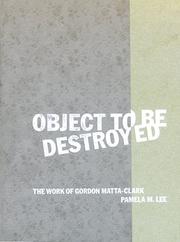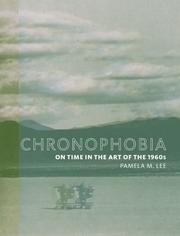| Listing 1 - 10 of 33 | << page >> |
Sort by
|

ISBN: 0262122200 Year: 2000 Publisher: Cambridge (Mass.) : MIT press,
Abstract | Keywords | Export | Availability | Bookmark
 Loading...
Loading...Choose an application
- Reference Manager
- EndNote
- RefWorks (Direct export to RefWorks)
"Although highly regarded during his short life - and honored by artists and architects today - the American artist Gordon Matta-Clark (1943-78) has been largely ignored within the history of art. Matta-Clark is best remembered for site-specific projects known as "building cuts." Sculptural transformations of architecture produced through direct cuts into buildings scheduled for demolition, these works now exist only as sculptural fragments, photographs, and film and video documentations. Matta-Clark is also remembered as a catalytic force in the creation of SoHo in the early 1970s. Through loft activities, site projects at the exhibition space 112 Greene Street, and his work at the restaurant Food, he participated in the production of a new social and artistic space."--BOOK JACKET. "In this first critical account of Matta-Clark's work, Lee considers it in the context of the art of the 1970s - particularly site-specific, conceptual, and minimalist practices - and its confrontation with issues of community, property, the alienation of urban space, the "right to the city," and the ideologies of progress that have defined modern building programs."--Jacket.
Gordon Matta-Clark 1945-1978 (° New York, VS) ; overleden in Antwerpen --- Kunst en architectuur ; ingrepen ; G. Matta-Clark --- Process Art --- Architectuur-sculpturen --- 7.07 --- 7.038 --- Kunstenaars met verschillende disciplines, niet traditioneel klasseerbare, conceptuele kunstenaars A - Z --- Kunstgeschiedenis ; 1950 - 2000 --- assemblages (kunst) --- Art --- assemblages [sculpture] --- Matta-Clark, Gordon --- anno 1970-1979 --- Deconstructivism (Architecture) --- Influence. --- Matta - Clark, Gordon --- Matta-Clark, Gordon 1945-1978 (°New York, Verenigde Staten). Gestorven te Antwerpen --- Architecture, Deconstructivist --- Deconstructionism (Architecture) --- Deconstructivist architecture --- Architecture, Modern --- Influence --- Matta-Clark, Gordon, --- Criticism and interpretation. --- Anarchitectuur

ISBN: 9780262622035 0262622033 Year: 2004 Publisher: London: MIT Press,
Abstract | Keywords | Export | Availability | Bookmark
 Loading...
Loading...Choose an application
- Reference Manager
- EndNote
- RefWorks (Direct export to RefWorks)
"In the 1960s art fell out of time; both artists and critics lost their temporal bearings in response to what E. M. Cioran called "not being entitled to time." This anxiety and uneasiness about time, which Pamela Lee calls "chronophobia," cut across movements, media, and genres, and was figured in works ranging from kinetic sculptures to Andy Warhol films. Despite its pervasiveness, the subject of time and 1960s art has gone largely unexamined in historical accounts of the period. Chronophobia is the first critical attempt to define this obsession and analyze it in relation to art and technology."--BOOK JACKET.
Art and technology --- Time in art --- Nineteen sixties --- History --- Time in art. --- Nineteen sixties. --- Art and technology - History - 20th century
Book
ISBN: 0262278065 1417560622 9780262278065 9781417560622 Year: 2004 Publisher: [Place of publication not identified] MIT Press
Abstract | Keywords | Export | Availability | Bookmark
 Loading...
Loading...Choose an application
- Reference Manager
- EndNote
- RefWorks (Direct export to RefWorks)
Art and technology --- Time in art --- Nineteen sixties --- Visual Arts --- Art, Architecture & Applied Arts --- Visual Arts - General --- 1960s --- 60s (Twentieth century decade) --- Sixties (Twentieth century decade) --- Twentieth century --- Technology and art --- Technology --- History --- Time in art. --- Nineteen sixties.
Book
ISBN: 9780262534468 0262534460 Year: 2012 Publisher: [Cambridge, Mass.]: MIT Press,
Abstract | Keywords | Export | Availability | Bookmark
 Loading...
Loading...Choose an application
- Reference Manager
- EndNote
- RefWorks (Direct export to RefWorks)
The work of art's mattering and materialization in a globalized world, with close readings of works by Takahashi Murakami, Andreas Gursky, Thomas Hirschhorn, and others. It may be time to forget the art world-or at least to recognize that a certain historical notion of the art world is in eclipse. Today, the art world spins on its axis so quickly that its maps can no longer be read; its borders blur. In Forgetting the Art World, Pamela Lee connects the current state of this world to globalization and its attendant controversies. Contemporary art has responded to globalization with images of movement and migration, borders and multitudes, but Lee looks beyond iconography to view globalization as a world process. Rather than think about the "global art world" as a socioeconomic phenomenon, or in terms of the imagery it stages and sponsors, Lee considers "the work of art's world" as a medium through which globalization takes place. She argues that the work of art is itself both object and agent of globalization. Lee explores the ways that art actualizes, iterates, or enables the processes of globalization, offering close readings of works by artists who have come to prominence in the last two decades. She examines the "just in time" managerial ethos of Takahashi Murakami; the production of ethereal spaces in Andreas Gursky's images of contemporary markets and manufacture; the logic of immanent cause dramatized in Thomas Hirschhorn's mixed-media displays; and the "pseudo-collectivism" in the contemporary practice of the Atlas Group, the Raqs Media Collective, and others. To speak of "the work of art's world," Lee says, is to point to both the work of art's mattering and its materialization, to understand the activity performed by the object as utterly continuous with the world it at once inhabits and creates.
Théorie de l'art --- Mondialisation --- Sociologie de la culture
Book
ISBN: 9789186243975 Year: 2017 Publisher: London : Koenig Books,
Abstract | Keywords | Export | Availability | Bookmark
 Loading...
Loading...Choose an application
- Reference Manager
- EndNote
- RefWorks (Direct export to RefWorks)
Book
Year: 2012 Publisher: Cambridge, Mass. MIT
Abstract | Keywords | Export | Availability | Bookmark
 Loading...
Loading...Choose an application
- Reference Manager
- EndNote
- RefWorks (Direct export to RefWorks)
Art --- philosophy of art --- globalization --- anno 2000-2099
Multi
ISBN: 9780262357029 026235702X 9780262043526 Year: 2020 Publisher: Cambridge, Mass. The MIT Press
Abstract | Keywords | Export | Availability | Bookmark
 Loading...
Loading...Choose an application
- Reference Manager
- EndNote
- RefWorks (Direct export to RefWorks)
Political philosophy. Social philosophy --- Aesthetics of art --- art criticism --- research centers [buildings] --- Modernist --- anno 1900-1999
Book
ISBN: 9780262017732 Year: 2012 Publisher: Cambridge (Mass.) MIT
Abstract | Keywords | Export | Availability | Bookmark
 Loading...
Loading...Choose an application
- Reference Manager
- EndNote
- RefWorks (Direct export to RefWorks)
Book
ISBN: 026212260X Year: 2004 Publisher: Cambridge MIT press
Abstract | Keywords | Export | Availability | Bookmark
 Loading...
Loading...Choose an application
- Reference Manager
- EndNote
- RefWorks (Direct export to RefWorks)
Art and technology --- Nineteen sixties --- Time in art --- History
Book
ISBN: 1118278356 9781118278352 Year: 2010 Publisher: Chichester, West Sussex Wiley-Blackwell
Abstract | Keywords | Export | Availability | Bookmark
 Loading...
Loading...Choose an application
- Reference Manager
- EndNote
- RefWorks (Direct export to RefWorks)
| Listing 1 - 10 of 33 | << page >> |
Sort by
|

 Search
Search Feedback
Feedback About UniCat
About UniCat  Help
Help News
News